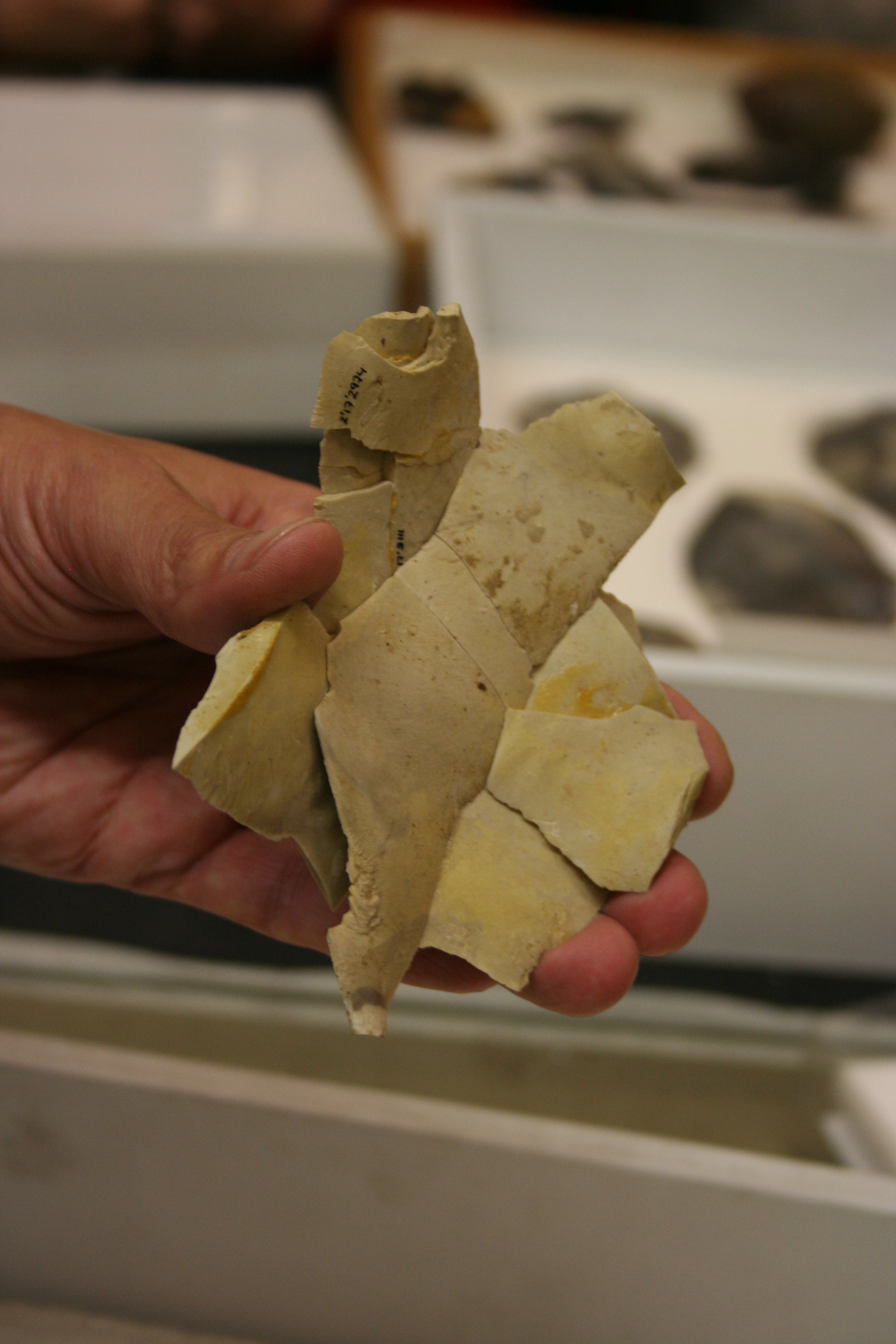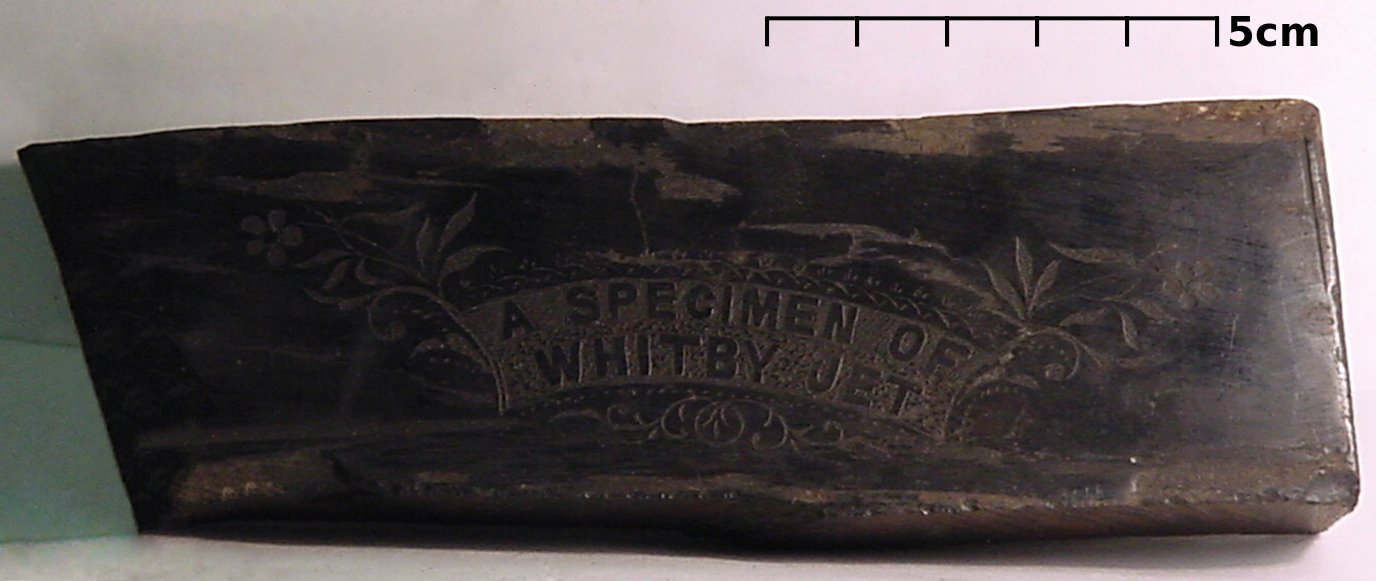|
Prismatic Blade
In archaeology, a prismatic blade is a long, narrow, specialized stone flake tool with a sharp edge, like a small razor blade. Prismatic blades are flaked from stone cores through pressure flaking or direct percussion. This process results in a very standardized finished tool and waste assemblage. The most famous and most prevalent prismatic blade material is obsidian, as obsidian use was widespread in Mesoamerica, though chert, flint, and chalcedony blades are not uncommon. The term is generally restricted to Mesoamerican archaeology, although some examples are found in the Old World, for example in a Minoan grave in Crete. Prismatic blades were used for cutting and scraping, and have been reshaped into other tool types, such as projectile points and awls. Morphology Prismatic blades are often trapezoidal in cross section, but very close in appearance to an isosceles trapezoid. Triangular blades (in cross-section) are also common. The ventral surface of the prismatic ... [...More Info...] [...Related Items...] OR: [Wikipedia] [Google] [Baidu] |
Archaeology
Archaeology or archeology is the scientific study of human activity through the recovery and analysis of material culture. The archaeological record consists of artifacts, architecture, biofacts or ecofacts, sites, and cultural landscapes. Archaeology can be considered both a social science and a branch of the humanities. It is usually considered an independent academic discipline, but may also be classified as part of anthropology (in North America – the four-field approach), history or geography. Archaeologists study human prehistory and history, from the development of the first stone tools at Lomekwi in East Africa 3.3 million years ago up until recent decades. Archaeology is distinct from palaeontology, which is the study of fossil remains. Archaeology is particularly important for learning about prehistoric societies, for which, by definition, there are no written records. Prehistory includes over 99% of the human past, from the Paleolithic until th ... [...More Info...] [...Related Items...] OR: [Wikipedia] [Google] [Baidu] |
Trapezoid
A quadrilateral with at least one pair of parallel sides is called a trapezoid () in American and Canadian English. In British and other forms of English, it is called a trapezium (). A trapezoid is necessarily a convex quadrilateral in Euclidean geometry. The parallel sides are called the ''bases'' of the trapezoid. The other two sides are called the ''legs'' (or the ''lateral sides'') if they are not parallel; otherwise, the trapezoid is a parallelogram, and there are two pairs of bases). A ''scalene trapezoid'' is a trapezoid with no sides of equal measure, in contrast with the special cases below. Etymology and ''trapezium'' versus ''trapezoid'' Ancient Greek mathematician Euclid defined five types of quadrilateral, of which four had two sets of parallel sides (known in English as square, rectangle, rhombus and rhomboid) and the last did not have two sets of parallel sides – a τραπέζια (''trapezia'' literally "a table", itself from τετράς (''tetrás'' ... [...More Info...] [...Related Items...] OR: [Wikipedia] [Google] [Baidu] |
John E
John is a common English name and surname: * John (given name) * John (surname) John may also refer to: New Testament Works * Gospel of John, a title often shortened to John * First Epistle of John, often shortened to 1 John * Second Epistle of John, often shortened to 2 John * Third Epistle of John, often shortened to 3 John People * John the Baptist (died c. AD 30), regarded as a prophet and the forerunner of Jesus Christ * John the Apostle (lived c. AD 30), one of the twelve apostles of Jesus * John the Evangelist, assigned author of the Fourth Gospel, once identified with the Apostle * John of Patmos, also known as John the Divine or John the Revelator, the author of the Book of Revelation, once identified with the Apostle * John the Presbyter, a figure either identified with or distinguished from the Apostle, the Evangelist and John of Patmos Other people with the given name Religious figures * John, father of Andrew the Apostle and Saint Peter * P ... [...More Info...] [...Related Items...] OR: [Wikipedia] [Google] [Baidu] |
Debitage
In archaeology, debitage is all the material produced during the process of lithic reduction – the production of stone tools and weapons by knapping stone. This assemblage may include the different kinds of lithic flakes and lithic blades, but most often refers to the shatter and production debris, and production rejects. Debitage analysis Debitage analysis, a sub-field of lithic analysis, considers the entire lithic waste assemblage. The analysis is undertaken by investigating differing patterns of debris morphology, size, and shape, among other things. This allows researchers to make more accurate assumptions regarding the purpose of the lithic reduction. Quarrying activities, core reduction, biface creation, tool manufacture, and retooling are believed to leave significantly different debitage assemblages. Lithic manufacture from a quarried source, or from found cobbles also leave different signatures. Some claim that they can determine the sort of tools used to creat ... [...More Info...] [...Related Items...] OR: [Wikipedia] [Google] [Baidu] |
Jet (lignite)
Jet is a type of lignite, the lowest rank of coal, and is a gemstone. Unlike many gemstones, jet is not a mineral, but is rather a mineraloid. It is derived from wood that has changed under extreme pressure. The English noun ''jet'' derives from the French word for the same material, (modern French ), ultimately referring to the ancient town of Gagae. Jet is either black or dark brown, but may contain pyrite inclusions which are of brassy colour and metallic lustre. The adjective " jet-black", meaning as dark a black as possible, derives from this material. Origin Jet is a product of decomposition of wood from millions of years ago, commonly the wood of trees of the family Araucariaceae. Jet is found in two forms, hard and soft. Hard jet is the result of carbon compression and salt water; soft jet may be the result of carbon compression and fresh water. Despite the name they both occupy the same area of the Mohs scale with the difference being that soft jet is more likely to ... [...More Info...] [...Related Items...] OR: [Wikipedia] [Google] [Baidu] |
Spain
, image_flag = Bandera de España.svg , image_coat = Escudo de España (mazonado).svg , national_motto = ''Plus ultra'' (Latin)(English: "Further Beyond") , national_anthem = (English: "Royal March") , image_map = , map_caption = , image_map2 = , capital = Madrid , coordinates = , largest_city = Madrid , languages_type = Official language , languages = Spanish , ethnic_groups = , ethnic_groups_year = , ethnic_groups_ref = , religion = , religion_ref = , religion_year = 2020 , demonym = , government_type = Unitary parliamentary constitutional monarchy , leader_title1 = Monarch , leader_name1 = Felipe VI , leader_title2 = Prime Minister , leader_name2 = Pedro Sánchez , legislature = C ... [...More Info...] [...Related Items...] OR: [Wikipedia] [Google] [Baidu] |
Toribio De Benavente Motolinia
Toribio of Benavente, O.F.M. (1482, Benavente, Spain – 1565, Mexico City, New Spain), also known as Motolinía, was a Franciscan missionary who was one of the famous Twelve Apostles of Mexico who arrived in New Spain in May 1524. His published writings are a key source for the history and ethnography of the Nahuas of central Mexico in the immediate post-conquest period as well as for the challenges of Christian evangelization. He is probably best known for his attacks on the Dominican defender of the rights of the indigenous peoples, Bartolomé de las Casas, who criticized the Conquest. Though agreeing with Las Casas's criticism of the abuses of the conquistadors, he did not agree with the whole sale condemnation of the Spanish Conquest, as well as his criticisms of the Franciscan practices of baptism en masse of the indigenous people of the new world. Due to these differences he went on to vilify Las Casas. Early life Toribio entered the Franciscan Order at the age of seven ... [...More Info...] [...Related Items...] OR: [Wikipedia] [Google] [Baidu] |
Spanish Conquest Of Mexico
The Spanish conquest of the Aztec Empire, also known as the Conquest of Mexico or the Spanish-Aztec War (1519–21), was one of the primary events in the Spanish colonization of the Americas. There are multiple 16th-century narratives of the events by Spanish conquistadors, their indigenous allies, and the defeated Aztecs. It was not solely a contest between a small contingent of Spaniards defeating the Aztec Empire but rather the creation of a coalition of Spanish invaders with tributaries to the Aztecs, and most especially the Aztecs' indigenous enemies and rivals. They combined forces to defeat the Mexica of Tenochtitlan over a two-year period. For the Spanish, the expedition to Mexico was part of a project of Spanish colonization of the New World after twenty-five years of permanent Spanish settlement and further exploration in the Caribbean. Significant events in the conquest of Mesoamerica Historical sources for the conquest of Mexico recount some of the same events in bo ... [...More Info...] [...Related Items...] OR: [Wikipedia] [Google] [Baidu] |
Mesoamerican Chronology
Mesoamerican chronology divides the history of prehispanic Mesoamerica into several periods: the Paleo-Indian (first human habitation until 3500 BCE); the Archaic (before 2600 BCE), the Preclassic or Formative (2500 BCE – 250 CE), the Classic (250–900 CE), and the Postclassic (); as well as the post European contact Colonial Period (1521–1821), and Postcolonial, or the period after independence from Spain (1821–present). The periodisation of Mesoamerica by researchers is based on archaeological, ethnohistorical, and modern cultural anthropology research dating to the early twentieth century. Archaeologists, ethnohistorians, historians, and cultural anthropologists continue to work to develop cultural histories of the region. Overview Paleo-Indian period 10,000–3500 BCE The Paleo-Indian (less frequently, '' Lithic'') period or era is that which spans from the first signs of human presence in the region, to the establishment of agricu ... [...More Info...] [...Related Items...] OR: [Wikipedia] [Google] [Baidu] |
Archaeological Site
An archaeological site is a place (or group of physical sites) in which evidence of past activity is preserved (either prehistoric or historic or contemporary), and which has been, or may be, investigated using the discipline of archaeology and represents a part of the archaeological record. Sites may range from those with few or no remains visible above ground, to buildings and other structures still in use. Beyond this, the definition and geographical extent of a "site" can vary widely, depending on the period studied and the theoretical approach of the archaeologist. Geographical extent It is almost invariably difficult to delimit a site. It is sometimes taken to indicate a settlement of some sort although the archaeologist must also define the limits of human activity around the settlement. Any episode of deposition such as a hoard or burial can form a site as well. Development-led archaeology undertaken as cultural resources management has the disadvantage (or the be ... [...More Info...] [...Related Items...] OR: [Wikipedia] [Google] [Baidu] |
Obsidian
Obsidian () is a naturally occurring volcanic glass formed when lava extruded from a volcano cools rapidly with minimal crystal growth. It is an igneous rock. Obsidian is produced from felsic lava, rich in the lighter elements such as silicon, oxygen, aluminium, sodium, and potassium. It is commonly found within the margins of rhyolitic lava flows known as obsidian flows. These flows have a high content of silica, granting them a high viscosity. The high viscosity inhibits diffusion of atoms through the lava, which inhibits the first step ( nucleation) in the formation of mineral crystals. Together with rapid cooling, this results in a natural glass forming from the lava. Obsidian is hard, brittle, and amorphous; it therefore fractures with sharp edges. In the past, it was used to manufacture cutting and piercing tools, and it has been used experimentally as surgical scalpel blades. Origin and properties The '' Natural History'' by the Roman writer Pliny the Elder inc ... [...More Info...] [...Related Items...] OR: [Wikipedia] [Google] [Baidu] |
Striking Platform
In lithic reduction, the striking platform is the surface on the proximal portion of a lithic flake on which the detachment blow falls;Kooyman, Brian Patrick. ''Understanding Stone Tools and Archaeological Sites''. University of Calgary Press, 2000, p. 12. this may be natural or prepared. Types of striking platforms include: * Cortex, which consists of an area of cortex used as a platform during initial reduction; * Single-faceted, consisting of a flat platform at right angles to the dorsal surface of the flake and most often associated with conchoidal fracture Conchoidal fracture describes the way that brittle materials break or fracture when they do not follow any natural planes of separation. Mindat.org defines conchoidal fracture as follows: "a fracture with smooth, curved surfaces, typically sligh ...s; * Double-faceted, a variety of multifaceted, prepared platform, also characteristically flat and associated with conchoidal fractures; * Multifaceted, with three or more ... [...More Info...] [...Related Items...] OR: [Wikipedia] [Google] [Baidu] |
.jpg)





.png)
